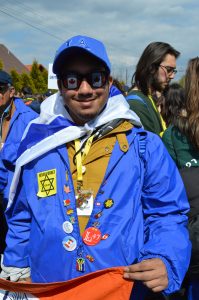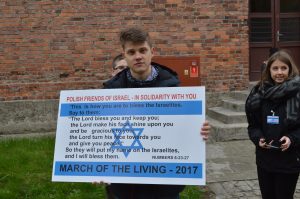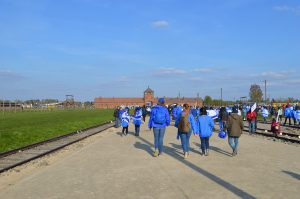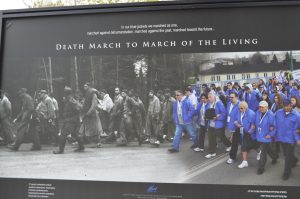HMDT Blog: March of the Living 2017
Jamie (Team Assistant) and Rachel (HMD Development Manager) from the HMDT staff team recently took part in March of the Living UK, a six day international educational trip which includes visits to former concentration camps and culturally significant sites associated with the Holocaust.
The programme culminates in an international march from Auschwitz I to Auschwitz-Birkenau, the two main sites of the largest Nazi extermination and concentration camp. Holocaust Memorial Day is marked on 27 January, the anniversary of the liberation of the camp. This is one of two blogs about their experiences and focuses on the march itself.
As we entered Auschwitz I, the anticipation was palpable. People begin toying with their pin badges and key chains and start to scout for what they deem a worthy swap. The bandanas from the LA March of the Living are considered the highest prize; what will you exchange for one of them?
 Which reminded some uncomfortably, of prisoners in Auschwitz who years ago, in the bleakest of circumstances, swapped their bread, their meagre food allowance, for a shirt to wear. Or those who swapped their shirts, the only clothes on their backs, for a little bit more bread, so desperate were they to eat a little more than their share.
Which reminded some uncomfortably, of prisoners in Auschwitz who years ago, in the bleakest of circumstances, swapped their bread, their meagre food allowance, for a shirt to wear. Or those who swapped their shirts, the only clothes on their backs, for a little bit more bread, so desperate were they to eat a little more than their share.
March of the Living has been running since 1988, with over 250,000 participants from 52 countries, this year over 12,000 people took part.
The spirit of March of the Living tends to divide people: some, like our friend in the photo, embrace the opportunity to swap items with others from around the world; others abhor the very act of the trade, and keep themselves to themselves; a third group respect that each individual has the right to choose – and find it empowering that we are able to choose, especially in Auschwitz where so many people had their choices taken away from them.
As we marched, many thoughts crossed our mind. There was chatter, singing, laughing. Should we be marching in silence? When the march first took place 19 years ago, participants were asked to walk in silence, in remembrance and commemoration. Yet here today young people walked side-by-side with survivors, sharing jokes, enjoying the company of family and friends. The meaning of March of the Living changes as each year passes, as it does to each of the participants. We have our own individual experiences and responses across the day and significance is implied and found in various moments.
For certain, there is an element of joy. To be able to march in defiance, in the antithesis of the death marches which brought about the murder of up to 250,000 people, celebrating lives and living was a truly life affirming experience, made all the more powerful by the fact that we were joined by people from all around the world.

Despite being a predominately Jewish gathering of communities from around the world, March of the Living attracts the attention of others. Stood inside Auschwitz I, and on the street outside, singing to those marching past, were a group of Polish people, standing in solidarity with the Jewish population. It was unclear who they were; residents of the town of Oświęcim? Christians offering their sympathies to those marching?
We speak to an elderly non-Jewish German lady, to find her reasons for taking part in the march. She tells us how she is there to ask for forgiveness for the atrocities of the Holocaust. Believing that God has forgiven her, she is there to seek forgiveness from us, those she perceived to be the future of the Jewish community.
Upon entering Auschwitz-Birkenau, the notorious image of the gatehouse loomed large as we headed beneath. Sombre versions of contemporary popular songs played over the loudspeakers, which at first seemed inappropriate.
As a mood-setter, however, its purpose was clear; after the relative joy and celebratory nature of the march, the mournful nature of the music reminded us where we were if the sight of the rows and rows of barracks disappearing into the distance were not enough.
 Every year the march from Auschwitz to Birkenau culminates in a ceremony with music, survivor testimony and speeches by representatives from attending countries. Finding a seat on the grass towards the far end of the camp to witness the ceremony, the mood changes again. To whom the ceremony is directly targeted is not clear, yet there is a unity in the words spoken. Messages of reassurance, solidarity and comfort, that we were all brought together to commemorate life in a place of death.
Every year the march from Auschwitz to Birkenau culminates in a ceremony with music, survivor testimony and speeches by representatives from attending countries. Finding a seat on the grass towards the far end of the camp to witness the ceremony, the mood changes again. To whom the ceremony is directly targeted is not clear, yet there is a unity in the words spoken. Messages of reassurance, solidarity and comfort, that we were all brought together to commemorate life in a place of death.
March of the Living is after all an experience that we share with those on the journey with us. As we retreat towards the buses, we meet those from other delegations and ask them what March of the Living means to them. For the group from Panama, to be able to share the experience with a survivor from their community, was an especially poignant moment. In contrast, the Moroccan delegation, never having met a survivor, were there to have new experiences and create a legacy within their community. 
Whatever the thoughts on the trading, the singing, the excitement, there is something incredible about 12,000 people who have chosen to take part in March of the Living and join in the short three-kilometre walk from Auschwitz to Birkenau.
As this photo so beautifully demonstrates, it was incredibly powerful to ‘counter’ the death marches, to walk into and out of Auschwitz, and to leave Auschwitz alongside survivors who never thought they would.
Thank you to March of the Living UK. If you would like to find out more information about the work they do or about attending next year, please visit marchoftheliving.org.uk.